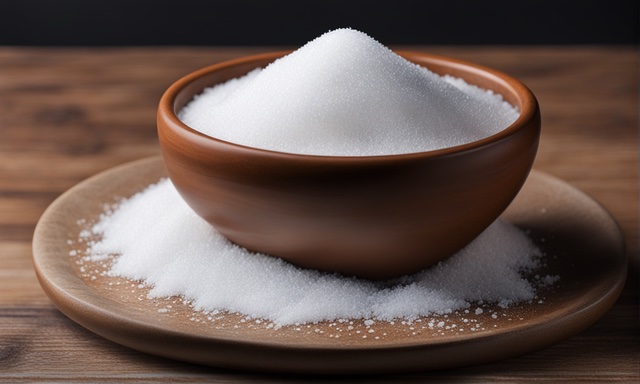Internet Asks: "Sorbitol Glycemic Index"
In a world where sugar substitutes are increasingly sought after, sorbitol has emerged as a popular choice, particularly for those monitoring their blood sugar levels. But what exactly is sorbitol, and how does it affect your glycemic response? This article delves into the world of sorbitol, focusing on its glycemic index and what that means for your diet.
sponsored links

What is Sorbitol?
Sorbitol is a type of sugar alcohol used as a low-calorie sweetener in many foods and beverages. It occurs naturally in fruits and vegetables but is often manufactured synthetically for commercial use. Unlike regular sugar, sorbitol is slowly metabolized by the body, leading to its use as a sugar substitute, especially for diabetic-friendly products.
Understanding Glycemic Index
The glycemic index (GI) is a measure that ranks foods on a scale from 0 to 100 based on how much they raise blood sugar levels after consumption. Foods with a high GI are quickly digested and absorbed, causing a rapid spike in blood sugar, whereas low-GI foods have a slower and more gradual impact.
Sorbitol’s Glycemic Index
Sorbitol has a relatively low glycemic index compared to regular sugar (sucrose). While sucrose has a GI of about 65, sorbitol's GI ranges from 9 to 13. This low glycemic impact makes sorbitol a preferable option for those looking to control blood sugar levels, such as individuals with diabetes.
Benefits of Using Sorbitol
- 1. Diabetes Management: For people with diabetes, low-GI foods like sorbitol can help maintain more stable blood glucose levels.
- 2. Weight Management: Foods with a low GI can aid in weight control as they tend to provide longer satiety and reduced hunger.
- 3. Dental Health: Sorbitol does not contribute to tooth decay like regular sugar, making it a teeth-friendly sweetener.
- 4. Calorie Control: Sorbitol provides about 60% of the sweetness of sugar with fewer calories, making it useful for weight management.
sponsored links
Sorbitol in a Balanced Diet
While sorbitol’s low GI makes it an appealing substitute for sugar, it’s important to consider its role in a balanced diet.
- - Moderation is Key: Excessive intake can lead to digestive issues like bloating, gas, and diarrhea, as the body cannot completely absorb sugar alcohols.
- - Not a Calorie-Free Sweetener: Sorbitol contains about 2.6 calories per gram, less than the 4 calories per gram in sugar, but it’s not calorie-free.
- - Read Labels Carefully: Look for sorbitol in the ingredients list of sugar-free or no-sugar-added products.
Conclusion
Sorbitol, with its low glycemic index, presents itself as a suitable sugar substitute, especially for those managing diabetes or watching their weight. Its ability to sweeten without significantly spiking blood sugar levels makes it a valuable component in a health-conscious diet. However, like any food product, moderation is essential, and individual responses can vary. Understanding the properties and effects of sorbitol can help consumers make informed choices about its use in their daily diet.
Disclaimer: This article is for informational purposes only and is not intended as medical advice. Consult with healthcare professionals for dietary advice tailored to your individual needs.
sponsored links
References
1. Mäkinen, K.K. (2016). "Gastrointestinal disturbances associated with the consumption of sugar alcohols with special consideration of xylitol: scientific review and instructions for dentists and other health-care professionals." International Journal of Dentistry, 2016. https://www.hindawi.com/journals/ijd/2016/5967907/
2. Fiona S. Atkinson, Kaye Foster-Powell, Jennie C. Brand-Miller; International Tables of Glycemic Index and Glycemic Load Values: 2008. Diabetes Care 1 December 2008; 31 (12): 2281–2283. https://doi.org/10.2337/dc08-1239
3. Medline Plus. Glycemic index and diabetes. https://medlineplus.gov/ency/patientinstructions/000941.htm
4. American Diabetes Association. Sugar Substitutes. https://professional.diabetes.org/sites/default/files/pel/source/sugar_substitutes.pdf
5. Karl F.
Tiefenbacher,
Chapter Three -
Technology of
Main
Ingredients—Sweeteners
and Lipids,
Editor(s):
Karl F.
Tiefenbacher,
Wafer and
Waffle, Academic
Press, 2017,
Pages 123-225,
ISBN
9780128094389,
https://doi.org/10.1016/B978-0-12-809438-9.00003-X.
People are also reading...
Does Sprite Have Caffeine?
Calories In Steak?
Chicken Taco Calories?
Does Hot Chocolate Have Caffeine?
Are Carrots Acidic?
Are Mangoes Acidic?
Orange Juice pH?
Does Kahlua Have Caffeine?
Calories In a Grilled Cheese?
Is Watermelon Acidic?
6 oz Steak Calories?
Are Strawberries Acidic?
Ready to level-up?
Create meal plans 10x faster, follow up with your clients through our mobile app, and never struggle with meal planning or recipe management again.